Other name: Eski Balat
The site of ancient Miletus could hardly be more different from that of nearby Priene, lying as it does right on the floodplain of the Büyük Menderes river with parts of the site underwater for much of the year. In its heyday Miletus was linked by a Sacred Way to the oracle in the Temple of Apollo at Didyma. Some of the huge statues that used to line the Way are now on display in Miletus Museum.
As at Priene, this is a site that was eventually abandoned rather than rebuilt over the centuries which means that extensive ruins remain to be visited.
Later, Miletus was an important city for the Menteşe Beylik and the restored İlyas Bey Cami is as important in its own way as the better known ruins of the ancient city. Other ruins of hans and hamams are scattered around the perimeter of the site.
Despite the importance of this site today aa air of neglect hangs over it. Although the museum has been restored and reopened much of the actual site is covered by unsightly algae. In contrast the mosque has been beautifully restored. This is a rare instance where visitors would be entitled to complain that the old non-Islamic heritage has been passed over in favour of the Islamic one.
The backstory
Although this was a site that was settled as long ago as the 16th century BC, it wasn’t until the seventh century that the great Miletus that gave birth to a succession of philosophers and intellectuals was born. This Miletus became one of the 12 cities of the Panionic League and was initially successful in standing up to the Persian invaders who poured into Ionia in the sixth century. However, it then made the fatal error of siding with the Athenians in a rebellion against the Persians, forfeiting its freedom in the process.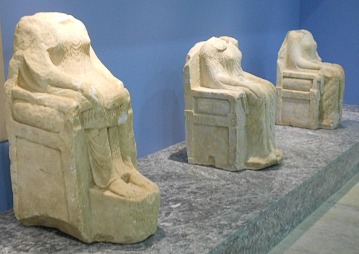 Statues from the Sacred Way to Didyma, Miletus Museum
Statues from the Sacred Way to Didyma, Miletus Museum
The city was rebuilt on a new site and went on to flourish under the Romans who were responsible for much of what is to be seen there today.
For a small place it produced a disproportionately large number of famous people, including the seventh-century astronomer and mathematician Thales; Aspasia, the 5th-century philosopher who became mistress to the Athenian leader Pericles; and, later, Isidore, one of the two men responsible for the design of Hagia Sophia (Ayasofya in İstanbul).
Miletus also bequeathed the Latin alphabet to the world, having picked it up from Phoenician traders and then transmitted it to Athens in 402 BC.
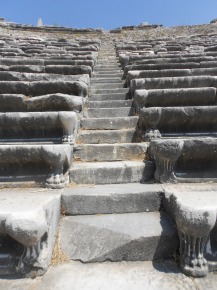 Around the site
Around the site
Far and away the most striking monument at Miletus is the stupendous, free-standing ancient theatre which was built to accommodate 15,000 people. Unexpectedly a castle was later built right above the top tier of seating.
From the top row of seats it’s possible to gaze out over the rest of the site which lies scattered to the north and east. There you will see the remains of a stadium, a bouleuterion (council chamber) and several ancient agoras (market places), one with the mosaic floors of adjoining houses or shops locked away inside a shed.
A lot of the site is under water for much of the year including what was once the Large Harbour, a site now dominated by a round plinth on which sits a monument adorned with the image of Poseidon. It was dedicated to the Roman general, Pompey, who had driven out pirates who had been making life difficult for the locals. It was probably erected in 63 BC.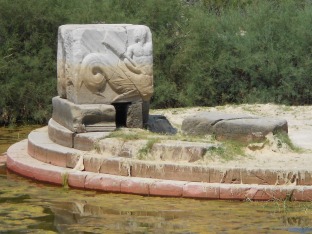 Large Harbour monument
Large Harbour monument
The most solid remaining structure once housed the Baths of Faustina which were built for, and named after, the wife of the second-century Roman Emperor, Marcus Aurelius.
One of the more picturesque bits of the site is the waterlogged area overlooked by the remains of a Temple to Apollo Delphinion. It sits right beside the hefty ruins of a hamam dating back to the Menteşe period.
Easily overlooked on the outskirts of the site are remains of a 3rd century Temple to Serapis, one of the Egyptian gods.
It would be a big mistake to view the ruins and then rush away because just a short walk away to the south stands another rather wonderful sight: the early 15th-century İlyas Bey Cami on the site of Eski Balat, much of its façade covered with marble shamelessly pilfered from the ruins.
The mosque was built by the Menteşe emir İlyas Bey in gratitude for the safe return of his wife who had been captured by Tamerlane in one of the never-ending raids that made life in the Middle Ages so insecure. Today both the mosque and the cells of the surrounding medrese have been restored. Also preserved here are the dank, bat-ridden remains of a contemporary hamam.
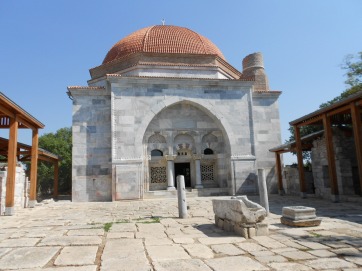 Restored İlyas Bey CamiMiletus Museum is apart from the ruins and closer to the mosque. One might argue that the building is too big and in the wrong location but the contents are beautifully presented.
Restored İlyas Bey CamiMiletus Museum is apart from the ruins and closer to the mosque. One might argue that the building is too big and in the wrong location but the contents are beautifully presented.
Transport info
There is only one minibus a day from Söke to Balat, near Miletus, leaving at 12 noon. Unfortunately it returns to Söke via a loop that does not include Balat which means that you will have to walk or hitchhike back to Akköy (5km) in order to get another bus. Balat is 1.5km from the ruins.
Such is the difficulty of getting to Miletus by public transport that without a car you’ll probably be better off signing up for a “PMD” tour taking in Priene and Didyma as well from either Selçuk or Kuşadası.
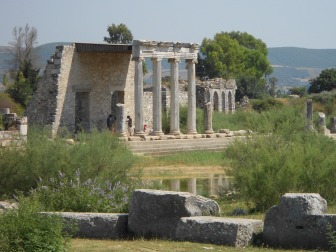 Temple of Apollo Delphinion
Temple of Apollo Delphinion

